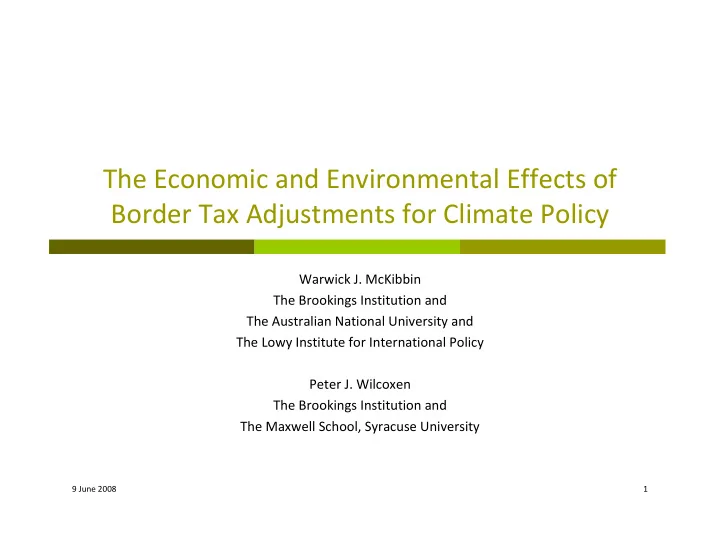

The Economic and Environmental Effects of Border Tax Adjustments for Climate Policy Warwick J. McKibbin The Brookings Institution and The Australian National University and The Lowy Institute for International Policy Peter J. Wilcoxen The Brookings Institution and The Maxwell School, Syracuse University 9 June 2008 1
Why border tax adjustments? � Some countries will impose carbon restrictions but others will not � Increase differences in energy costs: � Rise in countries controlling carbon; lower elsewhere � Energy intensive industry might migrate � Less effect on emissions: “leakage” � Border tax adjustments: � Impose equivalent tax on imports; refund taxes on exports � Motivations: � Reduce industry migration � Avoid emissions leakage � Punish non ‐ participating countries 9 June 2008 2
How would they work? � Compute carbon content embodied in each import � Levy tariffs to match domestic carbon controls � Example: � Production of X requires 0.1 tons of coal � Domestic carbon tax of $20 per ton of carbon � Coal is 65% carbon � Tariff would be 0.1*0.65*20 = $1.30 9 June 2008 3
Computing carbon content � Based on sum: � Fossil energy directly in producing the good � Fossil energy used in inputs to the good � Fossil energy used in inputs to inputs � ... � Example: Boeing 777 � Energy used by Boeing to assemble the plane � Energy used to produce sheet aluminum � Energy used to refine aluminum from bauxite � Energy used to mine bauxite 9 June 2008 4
Data on direct fuel use � Input ‐ output tables for each economy � Direct use of inputs by each industry � Example: in 1992, the construction industry used � $23.3 billion of “lumber and wood products” � $4.1 billion of “paints and allied products” � ... � Typically very detailed: � Some tables have 600+ industries and products � US table produced by the BEA from Census of Manufacturers, etc. 9 June 2008 5
Calculating total fossil fuel use ... Convert table to show inputs per unit of output 1. Divide each column by the industry’s output � Invert to obtain “total requirements” table 2. Input of each good used directly or indirectly to produce a unit of � output One row for each fossil fuel 3. One column for each product � 9 June 2008 6
... converting fuel use to tariffs Multiply inputs of fuels by emissions factors 4. Sum result to get carbon per unit of output � Multiply carbon content by effective carbon tax 5. Unit tax per unit of output � Convert to an ad valorem tariff 6. Divide by original price of the corresponding good � Alternately, could be a unit tax � 9 June 2008 7
Quantitative effects? � Assess using the G ‐ Cubed model of the world economy � Divided into 10 regions; some are individual countries � Regions are connected by bilateral flows � Trade in goods and services; flows of financial capital � Each region is represented by a separate submodel � 12 sectors of production � Households, government, financial sector, taxes, etc. � Input ‐ output data is used in building the regional models 9 June 2008 8
Regions and sectors in G ‐ Cubed Sectors: Regions: Electric utilities United States Gas utilities Japan Petroleum refining Australia Coal mining Europe Crude oil and gas extraction Other OECD countries Other mining China Agriculture India Forestry and wood products Developing countries Durable goods Eastern Europe & Former USSR Nondurables Oil exporting countries Transportation Services 9 June 2008 9
9 June 2008 10
9 June 2008 11
9 June 2008 12
Two pairs of border tax experiments � Case 1: Between regions with similar technology � 1a: Carbon tax in Europe only � 1b: Same plus European border taxes based on US energy intensity � Case 2: Between regions with different technology � 2a: Carbon tax in the US only � 2b: Same plus US border taxes based on China’s energy intensity � Presentation focuses on Case 1 9 June 2008 13
Details of the carbon tax � Initially $20 per metric ton of carbon � Rising by $0.50 per year to $40 � Fiscal deficits held constant � Revenues used to increase government spending 9 June 2008 14
9 June 2008 15
Carbon tax in Europe � Scenario 1a 9 June 2008 16
9 June 2008 17
9 June 2008 18
9 June 2008 19
9 June 2008 20
Now add European border tax adjustments... � Scenario 1b 9 June 2008 21
9 June 2008 22
9 June 2008 23
Summary of results � Border tax adjustments are small at this level of aggregation � Would be larger for some narrow industries: e.g., aluminum � Carbon tax drives most of the effects � Effects due to border taxes: � Modest reduction in leakage � Very little protective effect on domestic output 9 June 2008 24
Policy implications � Border tax adjustments would be difficult to administer � Vary by country of origin? � Account for production scattered across countries? � Tracking energy sources precisely: hydro vs. coal? � Not much effect on leakage � Emissions from electricity and domestic transportation � Most traded goods not very energy intensive � Are the gains are worth it? 9 June 2008 25
Recommend
More recommend